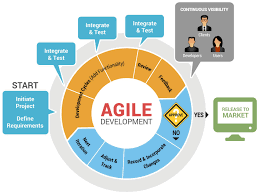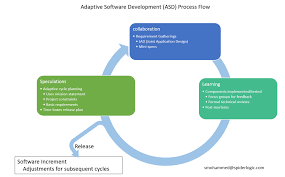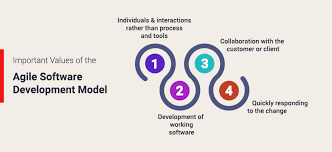Unlocking Success Through Agile Application Development Strategies
The Benefits of Agile Application Development
Agile application development is a methodology that emphasizes flexibility, collaboration, and iterative progress in software development projects. Unlike traditional waterfall approaches, agile development focuses on delivering working software in small, incremental releases. This approach allows teams to respond quickly to changing requirements and deliver value to customers faster.
Key Principles of Agile Development
Agile development is guided by several key principles:
- Iterative Development: Projects are broken down into small iterations or sprints, typically lasting 1-4 weeks. Each iteration results in a working piece of software that can be reviewed and tested.
- Collaboration: Cross-functional teams work closely together, including developers, testers, designers, and product owners. Collaboration is essential for rapid decision-making and problem-solving.
- Adaptability: Agile teams embrace change and welcome new requirements even late in the development process. This flexibility allows for continuous improvement based on feedback.
- Customer Focus: Agile development prioritizes customer satisfaction by delivering valuable features early and frequently. Customer feedback drives the direction of the project.
The Benefits of Agile Development
There are several benefits to adopting agile application development:
- Rapid Delivery: By breaking projects into smaller increments, teams can deliver working software more frequently, providing value to customers sooner.
- Flexibility: Agile methodologies allow for changes to be incorporated at any stage of the project, enabling teams to adapt to evolving requirements.
- Better Quality: Continuous testing and feedback loops help identify issues early in the development process, leading to higher-quality software.
- Improved Collaboration: Cross-functional teams collaborate closely throughout the project, fostering communication and teamwork.
- Increased Customer Satisfaction: By involving customers in the development process and delivering features incrementally, agile development ensures that customer needs are met effectively.
In conclusion, agile application development offers a flexible and collaborative approach to software development that prioritizes customer satisfaction and rapid delivery. By embracing agile methodologies, organizations can adapt quickly to changing requirements and deliver high-quality software that meets customer needs effectively.
9 Key Benefits of Agile Application Development: Speed, Flexibility, and Collaboration
- Faster time-to-market for software releases
- Increased adaptability to changing requirements
- Enhanced collaboration among cross-functional teams
- Improved transparency and visibility into project progress
- Higher customer satisfaction through frequent feature delivery
- Better quality control with continuous testing and feedback loops
- Reduced risks through early issue identification and mitigation
- Greater flexibility in responding to market demands and trends
- Empowerment of team members to make decisions and drive innovation
Challenges in Agile Application Development: Navigating Complexity, Scope Creep, and Customer Dependency
Faster time-to-market for software releases
Agile application development offers the advantage of faster time-to-market for software releases. By breaking down projects into smaller iterations and focusing on delivering working software in incremental releases, agile teams can bring new features and updates to market more quickly compared to traditional development approaches. This accelerated pace allows businesses to stay competitive, respond promptly to market demands, and gather valuable feedback from users early in the development process, ultimately leading to improved customer satisfaction and business outcomes.
Increased adaptability to changing requirements
Agile application development’s increased adaptability to changing requirements is a significant advantage that allows teams to respond effectively to evolving project needs. Unlike traditional development methods that may struggle with late-stage changes, agile methodologies enable seamless integration of new requirements at any point in the project timeline. This flexibility ensures that the final product aligns closely with the client’s vision and market demands, leading to higher customer satisfaction and a more successful end result.
Enhanced collaboration among cross-functional teams
Enhanced collaboration among cross-functional teams is a key advantage of agile application development. By bringing together individuals with diverse skills and expertise, agile methodologies promote communication, sharing of ideas, and collective problem-solving. This collaborative environment fosters a sense of teamwork and unity, allowing team members to work together seamlessly towards a common goal. As a result, cross-functional teams in agile development can leverage each other’s strengths, contribute unique perspectives, and deliver high-quality software solutions efficiently.
Improved transparency and visibility into project progress
Improved transparency and visibility into project progress is a significant benefit of agile application development. By breaking down projects into small iterations and holding regular meetings like daily stand-ups and sprint reviews, agile teams ensure that all stakeholders have a clear understanding of the project’s status. This transparency allows for better decision-making, early issue detection, and effective communication among team members, leading to increased accountability and alignment towards achieving project goals.
Higher customer satisfaction through frequent feature delivery
Agile application development excels in delivering higher customer satisfaction through frequent feature delivery. By breaking down projects into manageable increments and providing working software at regular intervals, agile teams ensure that customers receive value early and continuously throughout the development process. This approach allows for quick feedback loops, enabling teams to incorporate customer input promptly and adjust the product to meet evolving needs effectively. Ultimately, the emphasis on frequent feature delivery in agile development leads to increased customer satisfaction as customers see their requirements being addressed in a timely manner, resulting in a product that aligns closely with their expectations.
Better quality control with continuous testing and feedback loops
One of the key advantages of agile application development is the emphasis on better quality control through continuous testing and feedback loops. By conducting regular testing throughout the development process and incorporating feedback from stakeholders, agile teams can identify and address issues early on, ensuring that the final product meets high-quality standards. This proactive approach to quality assurance not only helps in detecting and resolving defects promptly but also results in delivering a more reliable and robust software solution to end-users.
Reduced risks through early issue identification and mitigation
One significant advantage of agile application development is the reduced risks through early issue identification and mitigation. By breaking down projects into smaller iterations and conducting continuous testing and feedback loops, agile teams can quickly identify and address potential issues before they escalate. This proactive approach not only helps in ensuring the quality of the software but also minimizes risks associated with project delays or budget overruns, ultimately leading to a more successful and efficient development process.
Greater flexibility in responding to market demands and trends
Agile application development provides organizations with greater flexibility in responding to market demands and trends. By breaking down projects into small iterations and incorporating changes easily throughout the development process, agile teams can quickly adapt to shifting market requirements and emerging trends. This agility allows businesses to stay competitive by delivering software that aligns with current market needs and customer preferences, ensuring that they can respond promptly to changes in the industry landscape.
Empowerment of team members to make decisions and drive innovation
Agile application development empowers team members by granting them the autonomy to make decisions and drive innovation within the project. This pro of agile methodology enables team members to take ownership of their work, fostering a sense of responsibility and creativity. By encouraging individuals to contribute ideas and solutions, agile development promotes a culture of innovation where team members feel motivated to explore new approaches and technologies that can enhance the project’s success. This empowerment not only boosts morale but also leads to more efficient problem-solving and continuous improvement throughout the development process.
Increased complexity
Increased complexity is a notable con of agile application development. The methodology’s emphasis on frequent communication and collaboration among team members, while beneficial for many aspects of the project, can also introduce challenges in project management. The need for constant coordination and decision-making may result in added layers of complexity that require careful navigation to ensure the project stays on track and meets its objectives efficiently. Balancing the benefits of collaboration with managing increased complexity is essential for successful implementation of agile development practices.
Potential for scope creep
The potential for scope creep is a significant con of agile application development. While the flexibility of agile methodologies allows for changes and adaptations, it can also lead to scope creep. This occurs when additional features are continuously introduced to the project without proper prioritization or consideration of the project’s original goals. Scope creep can result in project delays, increased costs, and a loss of focus on essential deliverables, ultimately impacting the overall success of the development process.
Dependency on customer availability
A significant drawback of agile application development is its dependency on customer availability. Agile methodologies require consistent feedback and active involvement from customers to ensure that the project aligns with their needs. However, this can pose a challenge when customers are not readily available or engaged in the development process. Delays in customer feedback can hinder progress and decision-making, potentially leading to inefficiencies and misunderstandings between the development team and the customer. This dependency on customer availability highlights a key limitation of agile development in scenarios where customer engagement is lacking or inconsistent.





